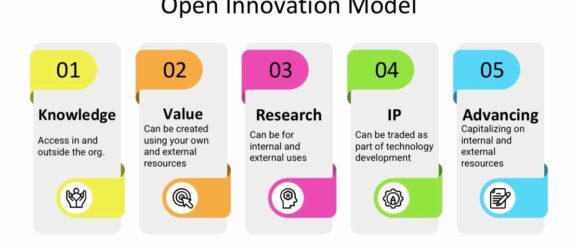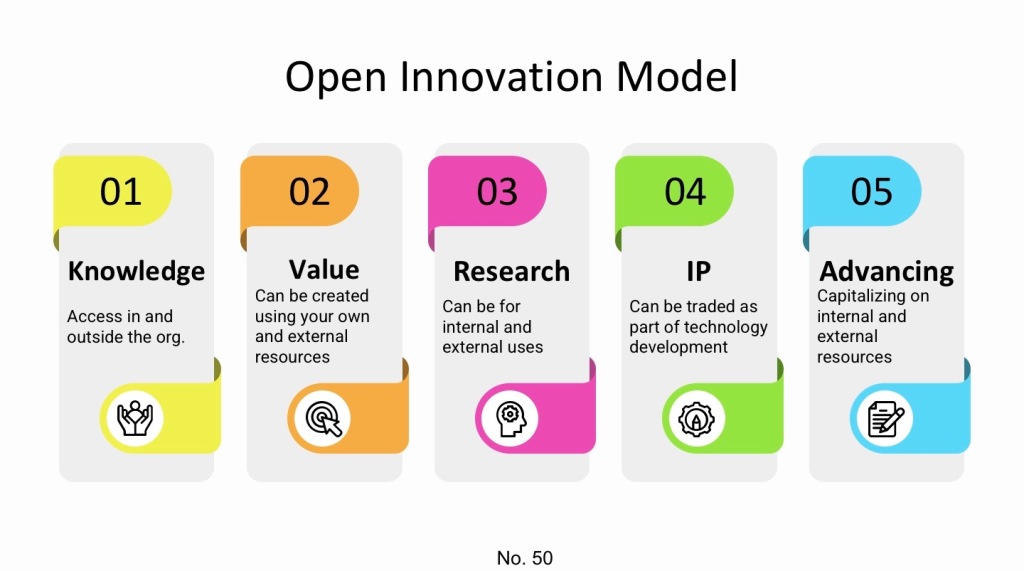What is the open innovation model, and how does it work?

Concept
In Chesbrough’s book ‘Open innovation’ 2003, he explained the open innovation model compared to the closed innovation and how the latter is not any more suitable (Chesbrough, 2003)1:
‘Open Innovation means that valuable ideas can come from inside or outside the company and go to market from inside or outside the company. This approach places external ideas and paths to the market on the same level of importance as that reserved for internal ideas and paths to the market during the Closed Innovation era. The availability and quality of these external ideas will change the logic that led to the formation of the centralised R&D silos of the Closed Innovation paradigm. Contrarily, closed innovation is pursuing the discovery and commercial development of scientific knowledge within the firm. However, close innovation is not applicable anymore because of erosion factors (e.g., ideas can no longer be inventoried on the shelf) that loosened the linkages between research and development.

Background
The open innovation model has been noted since the 1960s, highlighting the information age mindset toward innovation of secrecy, and the silo mentality of traditional corporate research labs and the benefits of increasing openness. Henry Chesbrough, an American organisational theorist known for coining the term open innovation, has been promoting open innovation and increasing the embrace of external cooperation in a complex world. Chesbrough’s book ‘ Open innovation’ 2003 argued the corrosion factors of closed innovation and the necessity of open innovation for the prosperity of businesses and world economies. He also designed a road map for corporates to replace the old thoughts of closed innovation with the most successful model of open innovation by applying the principles of open innovation.
How does it work?
Chesbrough’s book ‘ Open innovation’ of 2003 promoted the principles for businesses to embrace open innovation and benefit from the increased openness of external cooperation, as per the following highlights (Chesbrough, 2003)2:
How to access the useful knowledge
Today, knowledge is abundant in almost every field around you. The proliferation of public scientific databases and online journals and articles, combined with low-cost Internet access and high transmission rates, can give you access to a wealth of knowledge that was far more expensive and time-consuming to reach as recently as the early 1990s.
Toward a new logic of innovation
Instead of making money by hiding technology for your use, you make money by leveraging multiple paths to market your technology. Instead of restricting the research function only to your inventing new knowledge, good research practice also includes accessing and integrating external knowledge. Instead of managing intellectual property (IP) to exclude anyone else from using your technology, you can manage IP to advance your business model and to profit from your rivals’ use.
The new role of research
Open Innovation thinking changes the role of the research function. It expands the role of internal researchers to include not just knowledge generation, but also knowledge brokering. Previously, researchers simply added to the knowledge sitting in the silos. Today, they are also charged with moving knowledge into and out of the silos. In this new role, knowledge located from outside may be just as useful as knowledge created from within—and it should be similarly rewarded.
Open innovation and managing intellectual property (IP)
Open Innovation companies regard IP as an integral part of technology strategy and insist on managing it at a strategic level within the company. Not only are these companies interested in selling IP; they are motivated and informed buyers of IP, as well. One implication of Open Innovation is that companies must increase the “metabolic rate” at which they access, digest, and use knowledge. Companies cannot treat their knowledge as static; they must treat it as dynamic. A company cannot inventory technology advances on the shelf for the day when they may prove valuable. Open Innovation companies use licensing extensively to create and extend markets for their technology. And the faster the technology gets out of the lab, the sooner the researchers will learn new ways to apply, leverage, and integrate that technology into new offerings.
Advancing your current business
Open innovation can guide you to advance your current business by accessing external technology and knowledge, finding the blind spots (areas of no focus), reviewing external technologies and ideas, licensing external technology for your organisation’s uses, and funding start-ups to fill unmet needs your knowledge of your business and your markets.
Finding the best business model for your innovation
The question of which path to use for any innovation becomes one of, where is the best business model for that innovation. If your own business has an effective business model for the technology, then your business should fund its further development, which should be the preferred path to the market. If your business has complementary assets, then perhaps the new technology can enable you to extend your current business. If these are lacking, and if an external company has a business model that can profit from using the technology, then that may be an attractive path to market for the technology. If the technology lacks any obvious business model, internal or external, then it either must be abandoned, or some start-ups will have to take on the challenge of searching for a viable business model for the technology.
- This post is sourced from my new book- Your Guide To Reach Innovation.
Final note: the book- Your Guide To Reach Innovation, is an actionable guide to innovation from beginning to end. Enjoy reading the book, and I look forward to your reviews.
Author: Munther Al Dawood
References:
- Chesbrough, H., 2003. Open Innovation, Harvard Business Review Press, Boston Massachusetts.
- Chesbrough, H., 2003. Open Innovation, Harvard Business Review Press, Boston Massachusetts.
